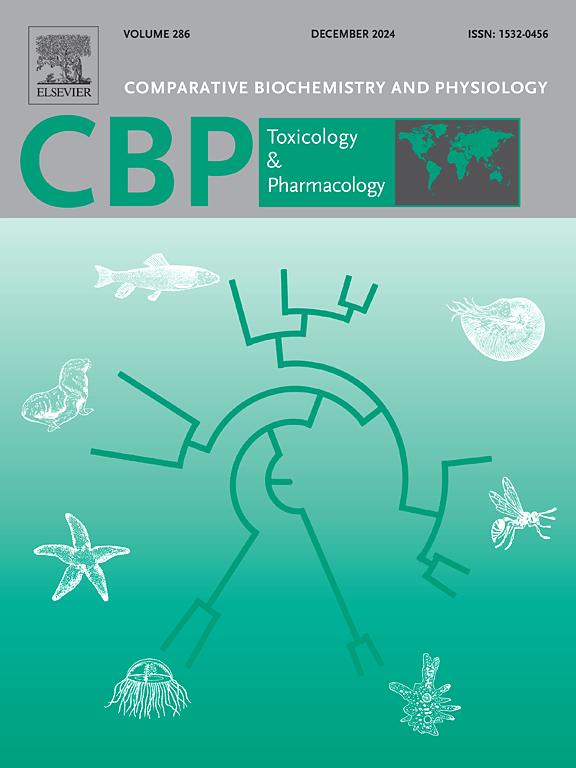Increasing temperature counteracts the negative effects of ultraviolet radiation on Microcystis aeruginosa under future climate scenarios in relation to physiological processes
IF 3.9
3区 环境科学与生态学
Q2 BIOCHEMISTRY & MOLECULAR BIOLOGY
Comparative Biochemistry and Physiology C-toxicology & Pharmacology
Pub Date : 2025-01-09
DOI:10.1016/j.cbpc.2025.110124
引用次数: 0
Abstract
Heat waves, are a major concern related to climate change, and are projected to increase in frequency and severity. This temperature rise causes thermal stratification, exposing surface-dwelling organisms to higher levels of ultraviolet radiation (UVR). This study aims to understand how the toxic bloom-forming cyanobacterium Microcystis aeruginosa adapts to changing climatic conditions. The effects of increased temperature and UVR were evaluated in terms of cell abundance, reactive oxygen and nitrogen species (ROS/RNS), the antioxidant activity of catalase (CAT), superoxide dismutase (SOD), glutathione S transferase (GST), fatty acid (FA) content, and lipid damage. Negative UVR effects on biomass, lipid damage, and polyunsaturated fatty acids (PUFAs) were more pronounced at 26 °C compared to 29 °C. However, antioxidant responses were higher at 29 °C. The relative abundance of ω6 FAs was less affected by UVA, while ω3 FAs were highly sensitive at 29 °C but unsaturated fatty acids (UFA) did not experience peroxidation. The differential response in FA to high temperature and UVR results in differences in lipid damage and antioxidants. Changes in membrane FA may suggest an adaptation strategy at high UVR conditions. The exposure to environmental changes can alter membrane fluidity, affecting cell physiology. Thus, to survive UVR exposure, M. aeruginosa maintains a balance between damage and stress adaptation, increasing the protection of selected PUFAs at high temperatures, allowing them to effectively cope with the harmful effects of elevated temperature and UVR.

温度升高可以通过生理过程抵消紫外线辐射对铜绿微囊藻在未来气候情景下的负面影响。
热浪是与气候变化有关的一个主要问题,预计其频率和严重程度将增加。这种温度上升导致热分层,使地表生物暴露在更高水平的紫外线辐射(UVR)下。本研究旨在了解形成有毒水华的蓝藻绿微囊藻如何适应不断变化的气候条件。从细胞丰度、活性氧和活性氮(ROS/RNS)、过氧化氢酶(CAT)、超氧化物歧化酶(SOD)、谷胱甘肽S转移酶(GST)的抗氧化活性、脂肪酸(FA)含量和脂质损伤等方面评价温度升高和紫外线辐射的影响。与29 °C相比,26 °C时UVR对生物量、脂质损伤和多不饱和脂肪酸(PUFAs)的负面影响更为明显。然而,在29 °C时,抗氧化反应更高。ω6脂肪酸的相对丰度受UVA的影响较小,而ω3脂肪酸在29 °C时高度敏感,但不饱和脂肪酸(UFA)不经历过氧化。脂肪酸对高温和紫外线的不同反应导致脂质损伤和抗氧化剂的差异。膜FA的变化可能表明在高紫外线辐射条件下的适应策略。暴露于环境变化可改变膜流动性,影响细胞生理。因此,为了在UVR暴露中生存,M. aeruginosa在损伤和应激适应之间保持平衡,增加了高温下选定PUFAs的保护,使它们能够有效应对高温和UVR的有害影响。
本文章由计算机程序翻译,如有差异,请以英文原文为准。
求助全文
约1分钟内获得全文
求助全文
来源期刊
CiteScore
7.50
自引率
5.10%
发文量
206
审稿时长
30 days
期刊介绍:
Part C: Toxicology and Pharmacology. This journal is concerned with chemical and drug action at different levels of organization, biotransformation of xenobiotics, mechanisms of toxicity, including reactive oxygen species and carcinogenesis, endocrine disruptors, natural products chemistry, and signal transduction with a molecular approach to these fields.

 求助内容:
求助内容: 应助结果提醒方式:
应助结果提醒方式:


